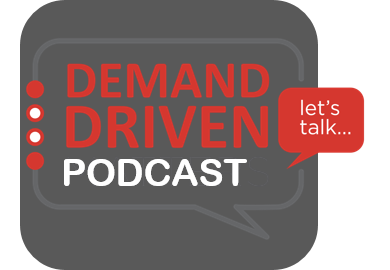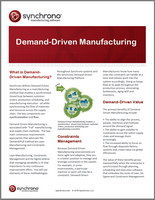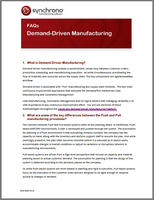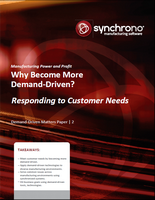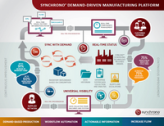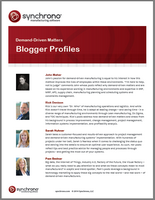 Three ways narrative can connect the dots between big data and your brand
Three ways narrative can connect the dots between big data and your brand
In a recent Forbes article, the writer describes Big Data as “a collection of data from traditional and digital sources inside and outside your company that represents a source for ongoing discovery and analysis.” I love this definition because it describes a process of discovery that—once linked with your brand message – allows you to uncover additional opportunities to tell compelling stories in the markets you serve.
I work in the manufacturing space, where our systems manage large amounts of real-time data aggregated from enterprise systems and machines in a client’s plant(s)—and all the way out to suppliers and customers. Manufacturers who harness this data gain insight to improve production flow; focus continuous improvement (CI) initiatives; and drive customer satisfaction via on-time delivery, innovation and increased capacity. This insight – and resulting capabilities – helps them transform into a more flexible, reactive and empowered business partner, creating a powerful story to tell in the marketplace. Sharing your most impactful big data stories will strengthen competitive advantage, profitability and your brand value.
Here are what I believe to be the three most compelling storylines for our manufacturing audience in what I call, “The Big Data Narrative”:
1. Pain Points
As marketers know well, features and benefits must solve specific customer problems. Spend some time brainstorming with your front-line people about the “pain” your customers are in and come up with an engaging narrative to show how your products can provide actionable information to solve these problems. Take care to create a distinction between a pile of data and actionable information that elicits “discovery” or insight into innovation. For example, our client was able to access actionable information to manage their inventory and WIP in a visible way and experience a 50% reduction in operating expenses. This customer’s pain point was ineffective inventory management, but they also had spotty supplier relationships. We helped them use and interpret their new system-generated data to create new synergies with their suppliers—a story worth the telling.
2. Related, Real-life Narratives
After you identify the pain, look at your past and current customers to give your big data solutions weight and depth. You’ll need case studies and testimonials like the one I used above. We often use case studies from our clients to paint a picture of value, particularly from those who use our InSync Services after implementation to jump start continuous improvement actions based on their new system-generated knowledge. We tell our products’ stories by telling these client stories—how they improved flow and continued to build value through their Big-Data-driven CI process. I love sharing the real-life ways that show how manufacturers use us to turn their big data into actionable information – and then into transformational improvements.
We also use stories to differentiate ourselves in the marketplace we serve. Because we have a unique position as a provider incorporating demand-driven manufacturing processes into our systems, we use stories from current clients to validate our value proposition to prospective clients. In turn, these customers use our stories to sell the solution internally to gain adoption.
3. Table the Tables?
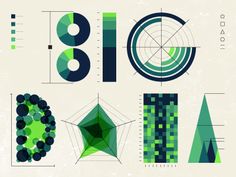 Mark Schaefer’s excellent blog post cautions against using too many pies, charts and graphs to tell the story—but let’s face it—70% of us are visual learners and supply-chain managers tend to want these graphics. They’re used to a dashboard approach and it would be a mistake not to give them one. In fact, the factory of the future is a visual environment, where status is easily viewed and actionable information is within reach, accessible to everyone. But don’t lose the people in the process of telling your story. Paint a “people picture” – use the shop foreman’s real first name – and don’t be afraid to use emotion as you translate Big Data into the big stories that create big results for your customers. As Schaefer puts it:
Mark Schaefer’s excellent blog post cautions against using too many pies, charts and graphs to tell the story—but let’s face it—70% of us are visual learners and supply-chain managers tend to want these graphics. They’re used to a dashboard approach and it would be a mistake not to give them one. In fact, the factory of the future is a visual environment, where status is easily viewed and actionable information is within reach, accessible to everyone. But don’t lose the people in the process of telling your story. Paint a “people picture” – use the shop foreman’s real first name – and don’t be afraid to use emotion as you translate Big Data into the big stories that create big results for your customers. As Schaefer puts it:
“If we distill the complex and nuanced world into only averages and pie charts, we could be missing the important opportunities presented by context. What’s the story behind the data? What’s there that we didn’t expect to be there? What are the implications of a trend and why is it happening?”
Ask these questions of your Big Data and you can show your audience the exponential value they will experience once they get a handle on their own story.
Let me know your Big Data stories. And thanks for reading mine!
– Marketing
 Big data, the Internet of Things, Industry 4.0, Factory of the Future, the Visual factory – what do you really need to pay attention to and what do these concepts mean to most manufacturers? A sceptic and trend-spotter, Pam’s posts leverage a background in technology marketing to apply these big concepts to the real world – and real work – of demand-driven manufacturers.
Big data, the Internet of Things, Industry 4.0, Factory of the Future, the Visual factory – what do you really need to pay attention to and what do these concepts mean to most manufacturers? A sceptic and trend-spotter, Pam’s posts leverage a background in technology marketing to apply these big concepts to the real world – and real work – of demand-driven manufacturers.
The post %%POSTLINK%% appeared first on %%BLOGLINK%%.






